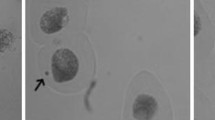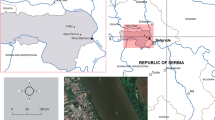Abstract
This study aimed at assessing the toxic effects of industrial effluents using duckweed (Lemna minor L.) plants as a test system. Growth inhibition test according to standardized protocol (ISO 20079) was performed. The suitability of the Comet assay (indicates DNA damage) and certain parameters such as peroxidase activity and lipid peroxidation level, as biomarkers for environmental monitoring was evaluated. The water samples were collected monthly over a 3-month period from the stream near the industrial estate of Savski Marof, Croatia. All samples caused inhibition of growth rates based on frond number and biomass as well as decrease of chlorophylls content. In contrast, peroxidase activity, malondialdehyde content and tail extent moment (measure of DNA strand breaks) markedly increased. Obtained data demonstrate the relevance of duckweed as sensitive indicators of water quality as well as the significance of selected biological parameters in the reliable assessment of phyto- and genotoxic potential of complex wastewaters.





Similar content being viewed by others
References
Aravind P, Prasad MNV (2003) Zinc alleviates cadmium-induced oxidative stress in Ceratophyllum demersum L.: a free floating freshwater macrophyte. Plant Physiol Biochem 41:391–397
Arnon DI (1949) Copper enzymes in isolated chloroplasts: polyphenoloxidase in Beta vulgaris. Plant Physiol 24:1–15
Arora A, Sairam RK, Srivastava GC (2002) Oxidative stress and antioxidative system in plants. Curr Sci 82:1227–1238
Axtell NR, Sternberg SPK, Claussen K (2003) Lead and nickel removal using Microspora and Lemna minor. Bioresource Technol 89:41–48
Bacon MA, Thompson DS, Davies WJ (1997) Can cell wall peroxidase activity explain the leaf growth response of Lolium temulentum during drought? J Exp Bot 48:2075–2085
Blokhina O, Virolainen E, Fagerstedt KV (2003) Antioxidants, oxidative damage and oxygen deprivation stress: a review. Ann Bot 91:179–194
Bradford MM (1976) A rapid and sensitive method for the quantitation of microgram quantities of protein utilizing the principle of protein–dye binding. Anal Biochem 72:248–254
Chance B, Maehly AC (1955) Assay of catalases and peroxidases. In: Colowick SP, Kaplan NO (eds) Methods in enzymology vol II. Academic Press, New York, pp 764–775
Elez L, Orescanin V, Sofilic T, Mikulic N, Ruk D (2008) Application of alkaline solid residue of electric arc furnace dust for neutralization/purification of electroplating wastewaters. J Environ Sci Health, Part A 43:1417–1423
Fry SC (1986) Cross-linking of matrix polymers in the growing cell walls of Angiosperms. Ann Rev Plant Physiol 37:165–186
Garnczarska M, Ratajczak L (2000a) Metabolic responses of Lemna minor to lead ions I. Growth, chlorophyll level and activity of fermentative enzymes. Acta Physiol Plant 22:423–427
Garnczarska M, Ratajczak L (2000b) Metabolic responses of Lemna minor to lead ions II. Induction of antioxidant enzymes in roots. Acta Physiol Plant 22:429–432
Gichner T, Patková Z, Száková J, Demnerová K (2004) Cadmium induces DNA damage in tobacco roots, but no DNA damage, somatic mutations or homologous recombination in tobacco leaves. Mutat Res 559:49–57
Heath RL, Packer L (1968) Photoperoxidation in isolated chloroplasts. I-kinetics and stoichiometry of fatty acid peroxidation. Arch Biochem Biophys 125:189–198
Horvat T, Vidaković-Cifrek Ž, Oreščanin V, Tkalec M, Pevalek-Kozlina B (2007) Toxicity assessment of heavy metal mixtures by Lemna minor L. Sci Total Environ 384:229–238
Hou W, Chen X, Song G, Wang Q, Chang CC (2007) Effects of copper and cadmium on heavy metal polluted waterbody restoration by duckweed (Lemna minor). Plant Physiol Biochem 45:62–69
ISO/DIS 20079 (2004) Water quality—determination of the toxic effect of water constituents and waste water to duckweed (Lemna minor)—duckweed growth inhibition test. ISO TC 147/SC 5/WG 5
John R, Ahmad P, Gadgil K, Sharma S (2008) Effect of cadmium and lead on growth, biochemical parameters and uptake in Lemna polyrrhiza L. Plant Soil Environ 54:262–270
Kanoun-Boulé M, Vicente JAF, Nabais C, Prasad MNV, Freitas H (2009) Ecophysiological tolerance of duckweeds exposed to copper. Aquat Toxicol 91:1–9
Kungolos AG, Brebbia CA, Samaras CP, Popov V (2006) Environ Toxicol. WIT Press, Southampton, UK
Küpper H, Küpper F, Spiller M (1996) Environmental relevance of heavy metal-substituted chlorophylls using the example of water plants. J Exp Bot 47:259–266
Lah B, Malovrh S, Narat M, Cepeljnik T, Marinsek-Logar R (2004) Detection and quantification of genotoxicity in wastewater-treated Tetrahymena thermophila using the comet assay. Environ Toxicol 19:545–553
Lichtenthaler HK (1987) Chlorophylls and carotenoids: pigments of photosynthetic membranes. Method Enzymol 148:350–382
Lin CC, Kao CH (2001) Cell wall peroxidase activity, hydrogen peroxide level and NaCl-inhibited root growth of rice seedlings. Plant Soil 230:135–143
Mackenzie SM, Waite S, Metcalfe DJ, Joyce CB (2003) Landfill leachate ecotoxicity experiments using Lemna minor. Water Air Soil Poll Focus 3:171–179
Matysik J, Alia BhaluB, Mohanty P (2002) Molecular mechanisms of quenching of reactive oxygen species by proline under stress in plants. Curr Sci 82:525–532
Mohan BS, Hosetti BB (1999) Aquatic plants for toxicity assessment. Environ Res 81:259–274
Naumann B, Eberius M, Appenroth K-J (2007) Growth rate based dose–response relationships and EC-values of ten heavy metals using the duckweed growth inhibition test (ISO 20079) with Lemna minor L. clone St. J Plant Physiol 164:1656–1664
Orescanin V, Lovrencic I, Mikelic L, Lulic S (2008) Applicability of MiniPal 4 compact EDXRF spectrometer for soil and sediment analysis. X-ray spectrom 37:508–511
Panda SK, Choudhury S (2005) Chromium stress in plants. Braz J Plant Physiol 17:95–102
Perfus-Barbeoch L, Leonhardt N, Vavasseur A, Forestier C (2002) Heavy metal toxicity: cadmium permeates through calcium channels and disturbs the plant water status. Plant J 32:539–548
Poschenrieder C, Barceló J (2004) Water relations in heavy metal stressed plants. In: Prasad MNV (ed) Heavy metal stress in plants: from biomolecules to ecosystems, 2nd edn edn. Springer, Berlin, pp 249–270
Sandalio LM, Dalurzo HC, Gómez M, Romero-Puertas MC, del Río LA (2001) Cadmium-induced changes in the growth and oxidative metabolism of pea plants. J Exp Bot 52:2115–2126
Siegel BZ, Galston AW (1967) The isoperoxidases of Pisum sativum. Plant Physiol 42:221–226
Siesko MM, FlemingWJ GrossfeldRM (1997) Stress protein synthesis and peroxidase activity in a submersed aquatic macrophyte exposed to cadmium. Environ Toxicol Chem 16:1755–1760
Srivastava S, Mishra S, Tripathi RD, Dwivedi S, Gupta DK (2006) Copper-induced oxidative stress and responses of antioxidants and phytochelatins in Hydrilla verticillata (L.f.) Royle. Aquat Toxicol 80:405–415
Steinberg R (1946) Mineral requirement of Lemna minor. Plant Physiol 21:42–48
Van Assche F, Clijsters H (1990) Effects of metals on enzyme activity in plants. Plant Cell Environ 13:195–206
Wang W, Freemark K (1995) The use of plants for environmental monitoring and assessment. Ecotox Environ Safe 30:289–301
Žegura B, Heath E, Černoša A, Filipič M (2009) Combination of in vitro bioassays for the determination of cytotoxic and genotoxic potential of wastewater, surface water and drinking water samples. Chemosphere 75:1453–1460
Acknowledgments
This study has been funded by Croatian Ministry of Science, Education and Sport, as part of Project no. 119-1191196-1202.
Author information
Authors and Affiliations
Corresponding author
Rights and permissions
About this article
Cite this article
Radić, S., Stipaničev, D., Cvjetko, P. et al. Ecotoxicological assessment of industrial effluent using duckweed (Lemna minor L.) as a test organism. Ecotoxicology 19, 216–222 (2010). https://doi.org/10.1007/s10646-009-0408-0
Received:
Accepted:
Published:
Issue Date:
DOI: https://doi.org/10.1007/s10646-009-0408-0




